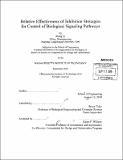Relative effectiveness of inhibition strategies for control of biological signaling pathways
Author(s)
Li, Meng, S.M. Massachusetts Institute of Technology
DownloadFull printable version (3.525Mb)
Other Contributors
Massachusetts Institute of Technology. Computation for Design and Optimization Program.
Advisor
Bruce Tidor.
Terms of use
Metadata
Show full item recordAbstract
Many therapeutically useful and critically important drugs are inhibitors of particular enzymes in a signaling pathway. The efficiency with which an inhibitor inactivates its target can be characterized by the binding kinetics and thermodynamics. However, the overall efficiency with which the inhibitor shuts down a pathway or process, arrests a signal, or interferes with an outcome can be quite different and is often measured in cell-based assays. Because of non-linear effects, particularly in signaling pathways but elsewhere as well, non-obvious and possibly useful relationships may exist such that much greater inhibition is needed at some points in a pathway as compared to others to achieve the same overall effect. To investigate the relationship between inhibiting a signaling molecule and interrupting the result of that signal, we used pathway simulations to study the effects of inhibition for different pathway components and the effect on pathway output. We use two biological characteristics to assess the inhibitory effects: the peak and integrated pathway response. In the epidermal growth factor receptor (EGFR) pathway, 50% inhibition of most enzymes in the pathway yields less than 50% reduction of the final activated ERK output. Inhibiting MEK was found most effective in EGFR pathway and it is more effective than directly inhibiting ERK itself. Inhibiting two signaling molecules at the same time yields an effect similar to the linear superposition of effects of inhibiting them separately. In the extrinsic apoptosis pathway, 50% inhibition of most signaling molecules in the pathway yields less than 50% reduction of the final caspase-3 output. The most effective inhibitor found is XIAP which is already included in the extrinsic apoptosis pathway.
Description
Thesis (S.M.)--Massachusetts Institute of Technology, Computation for Design and Optimization Program, 2010. Cataloged from PDF version of thesis. Includes bibliographical references (p. 36-38).
Date issued
2010Department
Massachusetts Institute of Technology. Computation for Design and Optimization ProgramPublisher
Massachusetts Institute of Technology
Keywords
Computation for Design and Optimization Program.